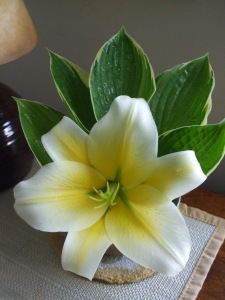Winter Weary or What
Confessions of a spring riser…

I don’t know about you, but this continuous cycle of snow, rain, melt, then heavy snow with more rain and more melt makes me shun my outside world. And it happens every spring. The rain gets my hopes up and then overnight it morphs into snow and I wake up to a white blanket that I thought I’d already discarded. I mean we Hostas have nothing against white blankets, but after a while they get soiled and need replacing with a green version, if you know what I mean.
Now back to spring. I can’t wait to peek out from under this soggy blanket. I’m usually among the first to emerge. You might say we hostas make a point of it even if we vary in size. Some of us, like my colleague “Sum and Substance”, can get to be over two metres wide. The more diminutive among us—dare I mention “Baby Bunting”— has a diameter of mere centimetres. No worries, though, we’re all the same really. We all covet the balmier temperatures of spring, right? My roots (which some prefer to call a family tree) go back to the Orient where temperatures were far less extreme. Since then, however, we’ve learned to flourish in a variety of climates—especially here in Nova Scotia.
When the days grow longer, we plan to rise, unfurl and revive our perennial lease on life, donning our blue, green, or yellow robes. Our blue coat is actually green with wax on top that makes it appear blue. Bet you didn’t know that! The wax tends to “melt” from the leaf following exposure to sun and heat. Our wardrobe may include combinations of lighter and darker shades. We may be dressed with “medio variegated” leaves that show a light color in the center of the leaf, which may be white, gold, yellow, or light green. Our “marginally variegated” leaves show only a light color on the edge of the leaf. Mind you, our colors may also be affected by the amount of sun we get.

Some of us prefer to make seasonal changes as well. A hosta that exhibits “viridiscence” will change from light colors in the leaf early in the growing season to all green leaves as the season progresses. “Lutescent” leaves will change from green to yellow, and “albescent” leaves will turn from yellow to white. If you can remember those terms, I’d tip my hat to you if I had one. The only toppings I can claim are slugs. And they don’t garner any praise—at least from the plants I know! Only those of us with thick and stiff leaves, termed “rugose,”see less of them. All these kinds of versatile leaves help us maintain a reputation for wrapping landscape with dependable, almost indestructible, foliage. And to boot, we can beautify a riverbank even under ubiquitous maritime evergreens. How would you look after months in the shade?

And if our roots get a little closer with time, don’t everyone’s? Yes, we do tend to stand our ground when it comes to moving. How would you feel? Who wants to start all over again? On the other hand, gardeners appreciate our steadfast character. What other plants would endure whip-snipping or being crushed to emerge as healthy as ever?

Landscapers hail this kind of hardiness, and floral designers delight in our curves as we swirl inside the confines of glass cages they call vases. So this spring, we’ll expect the usual, enthusiastic welcome. See you soon!
–submitted by Jocelyn Cameron,
Chester Garden Club Member
With information from Ohio State University: http://ohioline.osu.edu/hyg-fact/1000/1239.html
0 Replies to “Winter Weary or What”
Loved your imaginative email and the arrangements! Thank you . Jane
Thanks so much for your encouragement–much appreciated on my first attempt at blogging.
That was not only beautiful, it was educational. Can we have a hosta evening sometime?
Thanks so much–a hosta evening sounds like a great idea. Let’s “leaf” it with Esther!
I just love the garden in your photo at the top left.
Thanks so much–my first attempt at raised gardens!